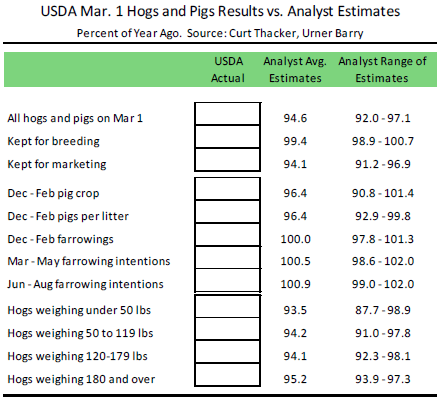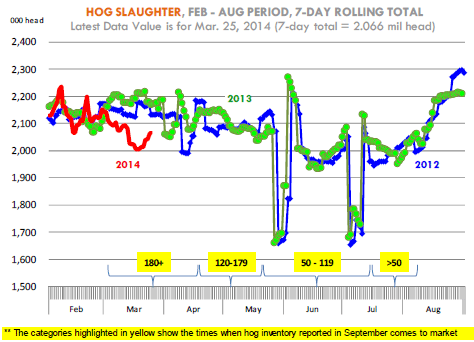



CME: Anticipation Ahead of Quarterly Hogs and Pigs Report
US - There is plenty of anticipation ahead of the USDA quarterly Hogs and Pigs inventory report. Hog futures, which mounted an impressive rally since mid January, have pulled back in the last two days as some market participants opt to move to the sidelines ahead of the report, write Steve Meyer and Len Steiner.Much of the impetus for the +30 per cent rally in summer hog futures has been speculation that the spread of PEDv virus among much of the US hog breeding operations has created a significant marketing hole that will be felt mostly during the June - Aug period.
This is a time of year when hog supplies are seasonally at the lowest point and significant disruptions in supply could create true product shortages, especially for end users that rely on a steady flow of fresh raw material.
Analysts polled by Urner Barry reporters appear quite ambivalent about the results of this latest survey, something that becomes apparent when looking at the wide variance in their estimates. On average, though, analyst estimates of summer and fall supplies appear to be smaller than futures are currently pricing.

Some of the more critical numbers to focus on:
- Pig crop during Dec—Feb. These are pigs that were born and survived during this period and which will come to market during the May—Jul period. Analyst estimates range from –9.2 per cent to +1.4 per cent, reflecting how much individual analysts believe the PEDv speculation. One thing that is important to keep in mind, however, is that depending how individual producers fill out the survey, the extent of the death losses may not be completely reflected in the pig crop number. One way to account for the death losses is to compute it as a residual of the inventory numbers at the start and the end of the period (1 December and 1 March), the pig crop, barrow and gilt slaughter and imported supplies. In the last report, USDA did show a decline in the number of pigs saved per litter but that number was smaller than expected. However, the calculated death loss number was significantly higher than in previous quarters, providing some sense of the impact of the disease. When the USDA numbers are released, there will be much focus on the pig crop number but it is also important to recognize the implied death loss statistic.
- The pig crop should correlate with the various hog inventory categories but not exactly. On average, analysts expect the pig crop to be down 3.6 per cent while the inventory of market hogs in the various categories is expected to be down from 3.9 per cent to 6.5 per cent. Again, these numbers are not as high as market expectations and, when accounting for the heavier weights, it implies an output shortfall of at most 5 per cent. The chart to the right shows hog slaughter and when the various inventory groups should come to market. Are analysts trying to guess the USDA report or are they just telling us what they really think will happen? It is hard to say but, at this point, they seem quite conservative and it appears some of them don’t quite buy the entire PEDv story.
- Finally, it is important to keep an eye on the breeding herd inventory. It is a key driver of hog supplies 11 months from now. Analysts expect the breeding stock to still be down 0.6 per cent from a year ago but there is plenty of uncertainty here as well. Big profits should drive expansion but the spread of PEDv remains a critical challenge to growth.









